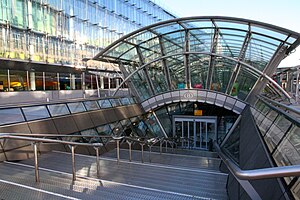Brussels-Luxembourg Station
| Railway station | |
 |
|
| Coordinates | 50°50′20″N 4°22′26″E / 50.83889°N 4.37389°ECoordinates: 50°50′20″N 4°22′26″E / 50.83889°N 4.37389°E |
| Owned by | National Railway Company of Belgium |
| Platforms | 6 |
| Other information | |
| Station code | LX |
| History | |
| Opened | 1854 |
Brussels-Luxembourg railway station (Dutch: Station Brussel-Luxemburg, French: Gare de Bruxelles-Luxembourg) is a station in the European Quarter of Brussels under the Esplanade of the European Parliament (part of the European Parliament complex in Brussels).
The station was built between 1854 and 1855 by the Grande Compagnie de Luxembourg as part of the Brussels-Luxembourg railway line it was constructing. The station was built to service the new Leopold Quarter, hence its original name of Leopold Quarter station. The lead architect was Gustave Saintenoy. He designed it in a neo-classical style in keeping with the other buildings around Place de Luxembourg which were designed around the same time. The station was Brussels' third, after those built in the Allée Verte and Rue des Bogards (which would eventually become Gare du Nord and Gare du Midi). Unlike those two however, Quartier Leopold station was designed as an intermediate stop rather than a terminal.
During the 19th century the station was divided into sections to differentiate the three different classes of travel. The station was extended in 1899 and 1921 with single storey pavilions, which were then amalgamated in 1934, when the facade was standardised.
Prior to its reconstruction in the 1990s and 2000s, the station was ground level with its front building facing the Luxembourg Square. It was redesigned as a subsurface-track station to make way for the European Parliament and a pedestrian link between Luxembourg Square and Leopold Park. The tracks were covered over and moved underground during the 1990s. The station's old building was partly demolished in 2004, with the central entrance building being incorporated into the Parliament's complex as an information office until 2016. Today, the central entrance has been repurposed as "Station Europe", a welcome point of the European Parliament. There, visitors can find many gadgets, such as an impressive augmented reality model of the campus, offering information on the Parliament, its buildings, its history and the famous personalities who came to visit. The entrance to the station is now a few metres to the south, via stairs descending down from the esplanade or via a ground floor entrance through Parliament's József Antall building on Rue de Trèves.
...
Wikipedia
